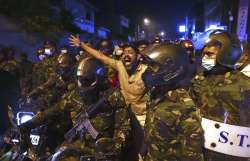As Sri Lanka faces its worst economic crisis, emergency declared; India offers helping hand | 10 points
President Gotabaya Rajapaksa has declared a nationwide public emergency amidst a spate of protests, including outside his house, over the worst economic crisis in the island nation.

Sri Lanka is currently experiencing its worst economic crisis in history. With long lines for fuel, cooking gas, essentials in short supply and long hours of power cuts the public has been suffering for weeks. President Gotabaya Rajapaksa has declared a nationwide public emergency amidst a spate of protests, including outside his house, over the worst economic crisis in the island nation.
Here are 10 points to note about Lanka's worst crisis in history:
- On the President's command, Secretary to the President Gamini Senarath issued the Extraordinary Gazette Notification. The move came after a violent protest erupted outside the residence of Rajapaksa on Thursday as hundreds of demonstrators gathered there and demanded his resignation for what they called his failure in addressing the worst economic crisis in the island nation.
- Senior police spokesperson Ajith Rohana told media that 24 police personnel and several other civilians were injured in the unrest, and several vehicles belonging to the police and army were torched by protesters. Total damage was estimated to be around $132,000 and the suspects will be charged with damaging public property, Rohana said.
- Rajapaksa's office blamed “organized extremists” within the thousands of protesters for violence during Thursday night's demonstration, where police fired tear gas and a water cannon and arrested 54 people. Dozens of other people were also injured.
- A foreign exchange crunch in Sri Lanka has led to a shortage of essential goods such as fuel and cooking gas. Power cuts that last up to 13 hours a day.
- Sri Lanka’s economic woes are blamed on successive governments not diversifying exports and relying on traditional cash sources like tea, garments and tourism, and on a culture of consuming imported goods.
- Rajapaksa has defended his government's actions, saying the foreign exchange crisis was not his making and the economic downturn was largely pandemic driven where the island’s tourism revenue and inward remittances waned.
- As a helping hand, Indian Oil supplies 6,000 MT of fuel to Ceylon Electricity Board. India has already started supplying rice to the crisis-hit country in first major food aid. Indian officials said that a consignment of 40,000 MT of diesel under Indian assistance through Line of Credit of $500 mn was handed over to Energy Minister Gamini Lokuge.
- The COVID-19 pandemic dealt a heavy blow to Sri Lanka’s economy, with the government estimating a loss of $14 billion in the last two years.
- Sri Lanka also has immense foreign debt after borrowing heavily on projects that don’t earn money. Its foreign debt repayment obligations are around $7 billion for this year alone.
- According to the Central Bank, inflation rose to 17.5% in February from 16.8% a month earlier. Its expected to continue rising because the government has allowed the local currency to float freely.
Also Read | Sri Lanka crisis: Protest outside President's house turns violent; country runs out of diesel
(inputs from agencies)